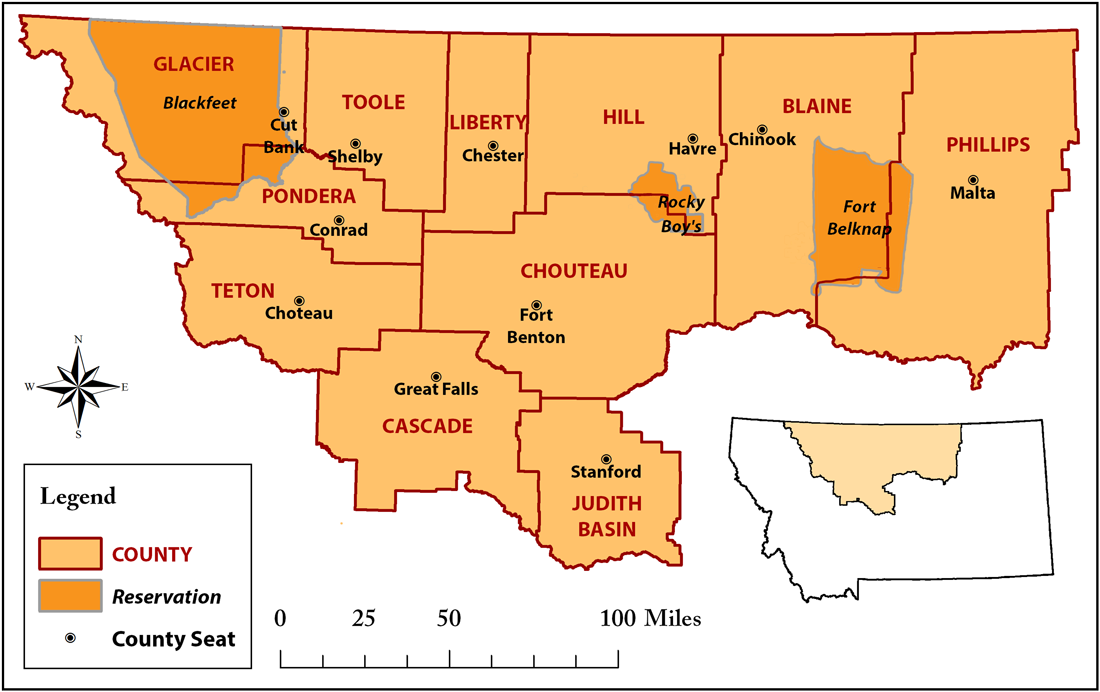North Central Montana Region

Opportunity Link serves 11 counties, 3 Indian reservations and the Little Shell Chippewa Tribe of Northcentral Montana. Opportunity Link’s region of Northcentral Montana has an area of over 31,000 square miles and is larger than ten other states. Poverty is one of the problems plaguing the region and eroding the quality of life for residents. Within this region, communities report approximately 70% unemployment, while entire counties report that up to 40% of families with children younger than five are living in poverty.
People continue to say it takes almost twice as much to get by as the federal government says it does. For a family of four with two adults and two children, the federal “poverty threshold” is $21,027, according to the US Census Bureau (2007). That means that a family whose yearly income is less than that is, according to the government, “in poverty”. Most of Northcentral Montana region has 1.5 to 2.5 times the rate of this federal standard and more than half of Montanans (52%) say that it takes at least $40,000 for a family of four to make ends meet in their community.
Priorities for Action
Percentage of Montanans who say this should be a “top” or “high” priority for elected officials:
- Keeping and attracting more businesses that have good-paying jobs – 77%
- Improving access to health care and dealing with health care costs – 66%
- Creating more affordable housing – 54%
- Improving public transportation – 27%
(Struggling to Make Ends Meet, Survey commissioned by the Northwest Area Foundation, 2008)
What We Can Do for the Region
Housing
Good quality, affordable housing is a key to community growth, economic development, and more balanced age distribution as it could incentivize young families, commuters or home-based entrepreneurs to move to rural and tribal communities. In most North Central Montana counties, the majority of residential structures were built before 1970.
- Affordable housing and housing for low-income families
- Senior housing
- Demolition of substandard housing to improve appearances and free up lots
- Renovation of older housing especially to improve energy efficiency
- More rentals and multi-family homes
Transportation
Transportation is critical when jobs, commercial goods, and other vital services (medical care, veterinary clinic, farm equipment repair) are located far from home. The cost of private automobile transportation, combined with cost of housing, can make commuting unaffordable for workers.
Population
In past decades, rural communities lost residents to out-migration as young workers moved to urban job markets; these communities now have, or soon will have, a predominance of older residents. Tribal communities experienced population growth due to a wealth of young children, plus the return of Indian retirees to home communities.
- Address declining population and shrinking tax base
- Desire to attract young families
- Need to provide services for elders, children
Marketing
The quality that residents like best about their hometown is PEOPLE. This was phrased many ways: the people; family and friends; community; friendly people; caring people; committed people; nice neighbors; taking care of one another. Residents also recognized the value of the small town way-of-life, historic Main Streets, secure communities, and good schools.
- Attract new residents, attract young families
- Retain young people
- Attract industry and professionals
- Attract consumers by revitalizing Main Street
Economic Development
Residents, and local economies, need jobs. Employers need a skilled and willing workforce.
- Develop more skilled workers
- Bring in better paying jobs
- Create more job opportunities
- Help small business start-ups or relocations
Charting Our Future
Scenario Planning workshops were held throughout the region in 2013 and attended by our elected officials, decision-makers, policy makers, residents, and partners. Scenarios develop descriptions about what could happen in the future based on key community indicators. Responses from these workshops were compiled and grouped into three possible scenarios – Continuing Trends, Boom-Bust, and Steady Growth. The Steady Growth scenario, defined by a steady regional growth pattern over the next 20 years that incorporated sustainable development ideas resonated most with the region’s residents. Highlights from these workshops can be viewed here.